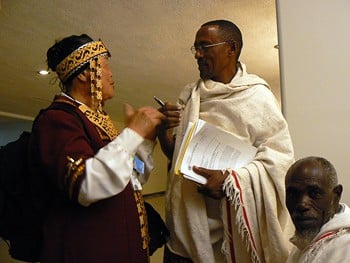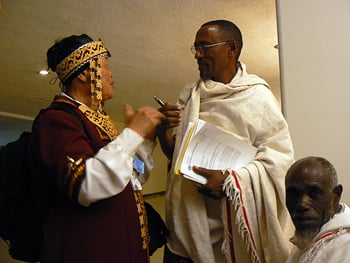
Making the case for indigenous peoples to be part of climate change solutions
MRG’s Media Officer, Farah Mihlar, gets to grips with how climate change is affecting indigenous communities at the UN Permanent Forum on Indigenous Issues.
Co-incidentally the focus of the morning TV news in New York was also on the environment. It was amazing how the debate on television news in a capital city (on the east coast) was simplified into entertaining little quizzes on whether you should do your dishes by machine or hand?! I would have thought that the world’s biggest polluter had moved beyond this level of discussion – there were no experts, there was no analysis, there weren’t even statistics – so a comfortable avoidance of where US households stand with their carbon foot print.
But inside the UN the debate was very different. At the Indigenous Peoples Forum I was attending, the communities contributing the least to pollution were explaining how they were suffering the most.
The Inuit and Sami communities who live in the Arctic across Alaska and Greenland and Scandinavia are severely affected by melting ice caps. Patricia Cochran of the Inuit Circumpolar Council explains to me that there have been cases where peoples and villages have simply vanished as a resulting of the melting snow. Sami reindeer herders speak of how their everyday lives are affected as warmer winters prevent the reindeer climbing to the top of the mountains to find their food.

Indigenous activist from Siberia (left) talking to pastoralists from Kenya
Further down in Ethiopia and Kenya pastoralist communities are finding the desserts hotter as a result of longer and more persistent droughts (I have pledged to stop complaining about the hot summers in Europe). They are dependent on their livestock, much of which is being lost to the drought together with people who die of the heat and starvation. The consequences are far reaching because in some cases men and specially women face exploitation as they migrate to cities and struggle to make a living.
In the pacific indigenous communities explain how the underwater sea life is for them similar to the forests that the South American Amazon dwellers are fighting to protect. For pacific tribes they are dependent on the fish and other sea-creatures who are affected by the rising water temperature that in turn is affecting the entire eco-system.
Every community represented at the UN from all regions of the world had their own unique story of how climate change was affecting them. Climate change for many years has been seen as a strictly environmental issue though later accepted as also a developmental issue. It is only now being recognized as a human rights issue but looking at it under a human rights lens is fairly new territory for many and that was clear even at the UN forum.
But for the indigenous communities it is less relevant how the debate is framed. For them the stark reality is that their communities are facing (or in some cases have already faced) a threat to life, development, self-determination, culture, etc. In some cases there is even a fear that entire communities may become extinct or at the least communities will lose fundamental aspects of their language, culture and literature that are so closely linked to nature.
This I think was the main point of emphasis at the forum – the exceptional, close relationship indigenous peoples have with the environment. Their dead live on in the soil, their Gods are in the waterfalls and the rivers, their spirits are in the wind. Their elders can interpret nature and have a way of communicating with the environment and although climate change challenges some aspects of this traditional knowledge these communities argue that their knowledgebase is diverse and they have historical experience of adaptation.
Hence the argument goes like this – because Indigenous peoples are the worst affected by climate change yet have the closest relationship to nature any solution on climate change should include them.
Getting world leaders grappling with issues of carbon footprints and CO2 emissions to also recognize this human cost is going to be tough one.
—
This article reflects the sole opinion of its author and does not engage MRG’s responsibility.